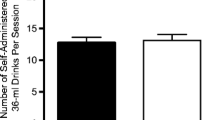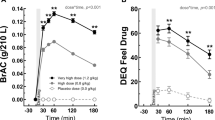Abstract
The purpose of the present study was to determine the preference for buspirone, an anxiolytic predicted to have minimal abuse potential, in comparison with diazepam in moderate drinkers. Preference for diazepam and buspirone was assessed in 55 moderate drinkers using a seven-session procedure consisting of four sampling sessions followed by three choice sessions. On each sampling session subjects ingested five capsules, one every 30 min. Color-coded capsules contained placebo on two sessions and drug on two sessions. Each drug capsule contained diazepam (4 mg) for 30 subjects and buspirone (5 mg) for 25 subjects. On choice sessions subjects chose whichever of the two color-coded capsules, i.e., drug or placebo, they wished to take. After ingesting one capsule, every 30 min they had the option of ingesting another capsule of the same color and content, for a maximum of seven capsules over the session (maximum of 28 mg diazepam or 35 mg buspirone). In the diazepam group 70% of subjects chose diazepam over placebo on at least two of the three choice sessions, whereas in the buspirone group only 24% of subjects chose buspirone over placebo on at least two sessions. Both diazepam and buspirone increased measures of sedation. Only diazepam increased ratings of liking and impaired performance, whereas only buspirone decreased ratings of feeling Friendly. These results replicate previous findings indicating that diazepam has reinforcing effects in moderate drinkers. Further, these results demonstrate the pharmacological specificity of this effect by showing that buspirone did not function as a reinforcer under these same conditions.
Similar content being viewed by others
References
Aranko K, Matilla MJ, Bordignon D (1985) Psychomotor effects of alprazolam and diazepam during acute and subacute treatment, and during the follow-up phase. Acta Pharmacol Toxicol 56: 364–372
Ashton H (1991) Protracted withdrawal syndromes from benzodiazepines. J Subst Abuse Treat 8: 19–28
Balster RL (1990) Abuse potential of buspirone and related drugs. J Clin Psychopharmacol 10: 31s-37s
Balster RL, Woolverton, WL (1982) Intravenous buspirone self-administration in rhesus monkeys. J Clin Psychiatry 43: 34–37
Barnas C, Rossmann M, Roessler H, Reimer Y, Fleischhacker WW (1992) Benzodiazepines and other psychoactive drugs abused by patients in a methadone maintenance program: familiarity and preference. J Clin Psychopharmacol 12: 397–402
Bond A, Lader M, Shrotriva R (1983) Comparative effects of a repeated dose regime of diazepam and buspirone on subjective ratings, psychological tests and the EEG. Eur J Clin Pharmacol 24: 463–467
Busto U, Simpkins MA, Sellers EM, Sisson B, Segal R (1983) Objective determination of benzodiazepine use and abuse in alcoholics. Br J Addict 78: 429–435
Ciraulo DA, Sands BF, Shader RI (1988) Critical review of liability for benzodiazepine abuse among alcoholics. Am J Psychiatry 145: 1501–1506
Cole JO, Orzack MH, Beake B, Bird M, Bar-Tal Y (1982) Assessment of the abuse liability of buspirone in recreational sedative users. J Clin Psychiatry 43 [12(Sec. 2)]: 69–74
Derogatis L (1983) SCL-90-R manual-II. Clinical Psychometric Research, Towson, Md.
de Wit H (1991) Diazepam preference in males with and without an alcoholic first-degree relative. Alcohol Clin Exp Res 15: 593–600
de Wit H, Griffiths RR (1991) Testing the abuse liability of anxiolytic and hypnotic drugs in humans. Drug Alcohol Depend 28: 83–111
de Wit H, Johanson CE, Uhlenhuth EH (1984a) Reinforcing properties of lorazepam in normal volunteer subjects. Drug Alcohol Depend 13: 31–41
de Wit H, Uhlenhuth EH, Johanson CE (1984b) Lack of preference for flurazepam in normal volunteers. Pharmacol Biochem Behav 21: 865–869
de Wit H, Uhlenhuth EH, Pierri J, Johanson CE (1984c) Preference for pentobarbital and diazepam in normal volunteer subjects. Fed Proc 43: 931
de Wit H, Uhlenhuth EH, Hedeker D, McCracken SM, Johanson CE (1986) Lack of preference for diazepam in anxious volunteers. Arch Gen Psychiatry 43: 533–541
de Wit H, Pierri J, Johanson CE (1989) Reinforcing and subjective effects of diazepam in nondrug-abusing volunteers. Pharmacol Biochem Behav 33: 205–213
Erwin CW, Linnoila M, Hartwell J, Erwin A, Guthrie S (1986) Effects of buspirone and diazepam, alone and in combination with alcohol, on skilled performance and evoked potentials. J Clin Psychopharmacol 6: 199–209
Feighner JP, Merideth CH, Hendrickson GA (1982) A double-blind comparison of buspirone and diazepam in outpatients with generalized anxiety disorder. J Clin Psychiatry 43: 103–107
Foltin RW, Evans SM (1993) Performance effects of drugs of abuse: a methodological survey. Hum Psychopharmacol 8: 9–19
Ghoneim MM, Mewaldt SP (1990) Benzodiazepines and human memory: a review. Anesthesiology 72: 926–938
Goldberg HL, Finnerty R (1982) Comparison of buspirone in two separate studies. J Clin Psychiatry 43: 87–91
Griffith JD, Jasinski DR, Casten GP, McKinney GR (1986) Investigation of the abuse liability of buspirone in alcohol-dependent patients. Am J Med 80 [suppl. 3B]: 30–35
Griffiths RR, Bigelow GE, Liebson I (1979) Human drug self-administration: double-blind comparison of pentobarbital, diazepam, chlorpromazine and placebo. J Pharmacol Exp Ther 210: 301–310
Griffiths RR, Bigelow GE, Liebson I, Kaliszak JE (1980) Drug preference in humans: double-blind choice comparison of pentobarbital, diazepam and placebo. J Pharmacol Exp Ther 215: 649–661
Griffiths RR, McLeod DR, Bigelow GE, Liebson IA, Roache JD (1984a) Relative abuse liability of diazepam and oxazepam: behavioral and subjective dose effects. Psychopharmacology 84: 147–154
Griffiths RR, McLeod DR, Bigelow GE, Liebson IA, Roache JD, Nowowieski P (1984b) Comparison of diazepam and oxazepam: preference, liking and extent of abuse. J Pharmacol Exp Ther 229: 501–508
Griffiths RR, Lamb RJ, Sannerud CA, Ator NA, Brady JV (1991) Self-injection of barbiturates, benzodiazepines and other sedative-anxiolytics in baboons. Psychopharmacology 103:154–161
Iguchi MY, Handelsman L, Bickel WB, Griffiths RR (1993) Benzodiazepine and sedative use/abuse by methadone maintenance clients. Drug Alcohol Depend 32: 257–266
Lader M (1982) Psychological effects of buspirone. J Clin Psychiatry 43: 62–67
Lader M (1991) Can buspirone induce rebound, dependence or abuse? Br J Psychiatry 159 [suppl.12]: 62–67
Linnoila M, Stapelton JM, Lister R, Moss H, Lane E, Granger A, Eckardt MJ (1990) Effects of single doses of alprazolam and diazepam, alone and in combination with ethanol, on psychomotor and cognitie performance and on autonomic nervous system reactivity in healthy volunteers. Eur J Clin Pharmacol 39: 21–28
Lucki I, Rickels K, Giesecke MA, Geller A (1987) Differential effects of the anxiolytic drugs, diazepam and buspirone, on memory function. Br J Clin Pharmacol 23: 207–211
Mattila M, Aranko K, Mattila MJ (1982) Acute effects of buspirone and alcohol on psychomotor skills. J Clin Psychiatry 43: 56–60
Mattila M, Seppålå T, Mattila MJ (1986) Combined effects of buspirone and diazepam on objective and subjective tests of performance in healthy volunteers. Clin Pharmacol Ther 40: 620–626
McCracken SG, de Wit H, Uhlenhuth EH, Johanson CE (1990) Preference for diazepam in anxious adults. J Clin Psychopharmacol 10: 190–196
McNair DM, Lorr M, Droppleman LF (1971) Profile of mood states (manual). Educational and Industrial Testing Services, San Diego, CA
New JS (1990) The discovery and development of buspirone: a new approach to the treatment of anxiety. Med Res Rev 10: 283–326
Pecknold JC, Matas M, Howarth BG, Ross C, Swinson R, Vezeau C, Ungar W (1989) Evaluation of buspirone as an antianxiety agent: buspirone and diazepam versus placebo. Can J Psychiatry 34: 766–771
Rickels K, Weisman K, Norstad N, Singer M, Stoltz D, Brown A, Danton J (1982) Buspirone and diazepam in anxiety: a controlled study. J Clin Psychiatry 43: 81–86
Roache JD, Griffiths RR (1985) Comparison of triazolam and pentobarbital: performance impairment, subjective effects and abuse liability. J Pharmacol Exp Ther 234: 120–133
Roache JD, Griffiths RR (1989) Diazepam and triazolam self-administration in sedative abusers: concordance of subject ratings, performance and drug self-administration. Psychopharmacology 99: 309–315
Sellers EM, Schneiderman JF, Romach MK, Kaplan HL, Somer GR (1992) Comparative drug effects and abuse liability of lorazepam, buspirone, and secobarbital in nondependent subjects. J Clin Psychopharmacol 12: 79–85
Sellers EM, Ciraulo DA, DuPont RL, Griffiths RR, Kosten TR, Romach MK, Woody GE (1993) Alprazolam and benzodiazepine dependence. J Clin Psychiatry 54 [suppl. No. 10]: 64–75
Steinberg RD (1990) Lack of abuse potential with buspirone (letter). Ann Pharmacother 24: 785
Troisi JR II, Critchfield TS, Griffiths RR (1993) Buspirone and lorazepam abuse liability in humans: behavioral effects, subjective effects and choice. Behav Pharmacol 4: 217–230
Wechsler D (1958) The measure and appraisal of adult intelligence. Williams and Wilkins, Baltimore, MD
Wheatley D (1982) Buspirone: Multicenter efficacy study. J Clin Psychiatry 43: 92–94
Wolf B, Iguchi MY, Griffiths RR (1989) Sedative/tranquilizer use and abuse in alcoholics currently in outpatient treatment: incidence, pattern and preference. National Institute on Drug Abuse, Research Monograph Series No. 95, pp 376–377
Woods JH, Katz JL, Winger G (1992) Benzodiazepines: use, abuse, and consequences. Pharmacol Rev 44: 151–347
Author information
Authors and Affiliations
Rights and permissions
About this article
Cite this article
Evans, S.M., Griffiths, R.R. & de Wit, H. Preference for diazepam, but not buspirone, in moderate drinkers. Psychopharmacology 123, 154–163 (1996). https://doi.org/10.1007/BF02246172
Received:
Revised:
Issue Date:
DOI: https://doi.org/10.1007/BF02246172




